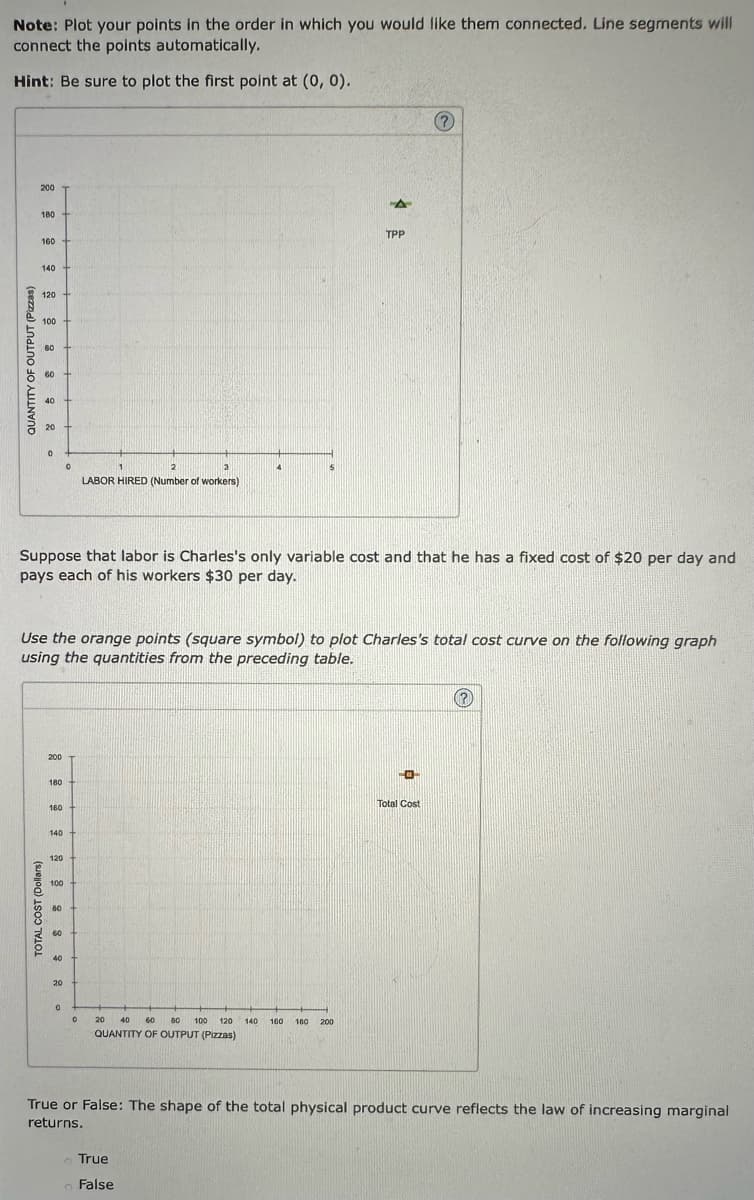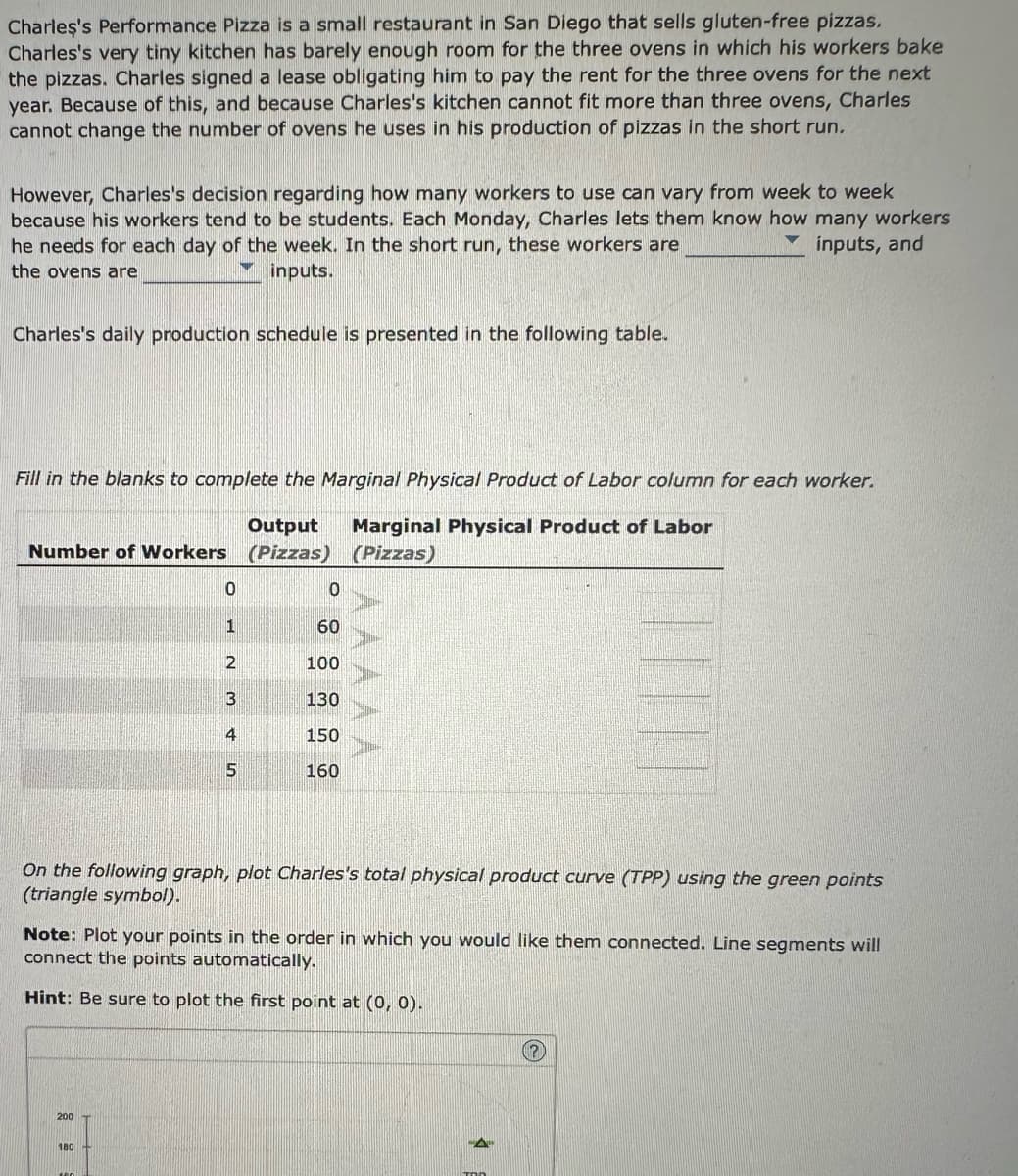However, Charles's decision regarding how many workers to use can vary from week to week because his workers tend to be students. Each Monday, Charles lets them know how many workers he needs for each day of the week. In the short run, these workers are inputs, and the ovens are inputs. Charles's daily production schedule is presented in the following table.
However, Charles's decision regarding how many workers to use can vary from week to week because his workers tend to be students. Each Monday, Charles lets them know how many workers he needs for each day of the week. In the short run, these workers are inputs, and the ovens are inputs. Charles's daily production schedule is presented in the following table.
Chapter11: Profit Maximization
Section: Chapter Questions
Problem 11.9P
Related questions
Question
Uncertain how to solve these sets of problems

Transcribed Image Text:Note: Plot your points in the order in which you would like them connected. Line segments will
connect the points automatically.
Hint: Be sure to plot the first point at (0, 0).
QUANTITY OF OUTPUT (Pizzas)
200 T
180
160
140 +
120
100
60
60
TOTAL COST (Dollars)
40
20
0
200
180
160
Suppose that labor is Charles's only variable cost and that he has a fixed cost of $20 per day and
pays each of his workers $30 per day.
140
Use the orange points (square symbol) to plot Charles's total cost curve on the following graph
using the quantities from the preceding table.
120
100
60
60
40
0
20
2
3
LABOR HIRED (Number of workers)
0
0 20 40
60
QUANTITY OF OUTPUT (Pizzas)
4
A
True
False
TPP
60 100 120 140 100 180 200
?
0
Total Cost
(?)
True or False: The shape of the total physical product curve reflects the law of increasing marginal
returns.

Transcribed Image Text:Charles's Performance Pizza is a small restaurant in San Diego that sells gluten-free pizzas.
Charles's very tiny kitchen has barely enough room for the three ovens in which his workers bake
the pizzas. Charles signed a lease obligating him to pay the rent for the three ovens for the next
year. Because of this, and because Charles's kitchen cannot fit more than three ovens, Charles
cannot change the number of ovens he uses in his production of pizzas in the short run.
However, Charles's decision regarding how many workers to use can vary from week to week
because his workers tend to be students. Each Monday, Charles lets them know how many workers
he needs for each day of the week. In the short run, these workers are
the ovens are
inputs, and
inputs.
Charles's daily production schedule is presented in the following table.
Fill in the blanks to complete the Marginal Physical Product of Labor column for each worker.
Output Marginal Physical Product of Labor
(Pizzas)
Number of Workers (Pizzas)
200
ON M & S
180
0
100
1
2
3
4
5
On the following graph, plot Charles's total physical product curve (TPP) using the green points
(triangle symbol).
0
60
100
130
Note: Plot your points in the order in which you would like them connected. Line segments will
connect the points automatically.
Hint: Be sure to plot the first point at (0, 0).
150
160
Expert Solution
This question has been solved!
Explore an expertly crafted, step-by-step solution for a thorough understanding of key concepts.
Step by step
Solved in 3 steps with 4 images

Knowledge Booster
Learn more about
Need a deep-dive on the concept behind this application? Look no further. Learn more about this topic, economics and related others by exploring similar questions and additional content below.Recommended textbooks for you


Principles of Economics 2e
Economics
ISBN:
9781947172364
Author:
Steven A. Greenlaw; David Shapiro
Publisher:
OpenStax



Principles of Economics 2e
Economics
ISBN:
9781947172364
Author:
Steven A. Greenlaw; David Shapiro
Publisher:
OpenStax
